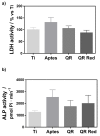Quercitrin Nanocoated Implant Surfaces Reduce Osteoclast Activity In Vitro and In Vivo
- PMID: 30366383
- PMCID: PMC6274788
- DOI: 10.3390/ijms19113319
Quercitrin Nanocoated Implant Surfaces Reduce Osteoclast Activity In Vitro and In Vivo
Abstract
In this study, the effect on osteoclast activity in vitro and in vivo of titanium implants that were coated with quercitrin was evaluated. Titanium surfaces were covalently coated with the flavonoid quercitrin. The effect of the surfaces on osteoclastogenesis was first tested in vitro on RAW264.7 cells that were supplemented with receptor activator of nuclear factor kappa-B ligand (RANKL) to generate osteoclast-like cells by tartrate-resistant acid phosphatase (TRAP) inmunostaining after five days of culture, and by analysis of the mRNA expression levels of markers related to bone resorption after seven days of culture. A rabbit tibial model was used to evaluate the in vivo biological response to the implant surfaces after eight weeks of healing, analyzing the lactate dehydrogenase (LDH) and the alkaline phosphatase (ALP) activities in the wound fluid that were present at the implant interface and the peri-implant bone mRNA expression levels of several markers related to inflammation, bone resorption and osteoblast-osteoclast interaction. No differences between groups and control surfaces were found in the wound fluid analyses. Moreover, quercitrin implant surfaces significantly decreased the expression of osteoclast related genes in vitro (Trap, CalcR, Ctsk, H⁺ATPase, Mmp9) and in vivo (Ctsk, H⁺ATPase, Mmp9) as well as the expression of RankL in vivo. Moreover, quercitrin surfaces were not cytotoxic for the cells. Thus, quercitrin implant surfaces were biocompatible and decreased osteoclastogenesis in vitro and in vivo. This could be used to improve the performance of dental implants.
Keywords: animal experiments; biomaterials; bone implant interactions; polyphenols; surface chemistry.
Conflict of interest statement
We declare the following conflicts of interest: A.C., M.M. and J.M.R. are inventors of a pending patent application based on some aspects of this work (PCT/EP2013/058116). The funders had no role in the design of the study; in the collection, analyses or interpretation of data; in the writing of the manuscript; and in the decision to publish the results.
Figures






Similar articles
-
Quercitrin and taxifolin stimulate osteoblast differentiation in MC3T3-E1 cells and inhibit osteoclastogenesis in RAW 264.7 cells.Biochem Pharmacol. 2013 Nov 15;86(10):1476-86. doi: 10.1016/j.bcp.2013.09.009. Epub 2013 Sep 20. Biochem Pharmacol. 2013. PMID: 24060614
-
Correlation between molecular signals and bone bonding to titanium implants.Clin Oral Implants Res. 2013 Sep;24(9):1035-43. doi: 10.1111/j.1600-0501.2012.02496.x. Epub 2012 May 16. Clin Oral Implants Res. 2013. PMID: 22587025
-
Quercetin triggers apoptosis of lipopolysaccharide (LPS)-induced osteoclasts and inhibits bone resorption in RAW264.7 cells.Cell Physiol Biochem. 2012;30(1):123-36. doi: 10.1159/000339052. Epub 2012 Jan 8. Cell Physiol Biochem. 2012. PMID: 22759961
-
Cellular responses evoked by different surface characteristics of intraosseous titanium implants.Biomed Res Int. 2015;2015:171945. doi: 10.1155/2015/171945. Epub 2015 Feb 12. Biomed Res Int. 2015. PMID: 25767803 Free PMC article. Review.
-
Modulation of Osteoclast Interactions with Orthopaedic Biomaterials.J Funct Biomater. 2018 Feb 26;9(1):18. doi: 10.3390/jfb9010018. J Funct Biomater. 2018. PMID: 29495358 Free PMC article. Review.
Cited by
-
Change in the Dominant Side of Chewing as a Serious Factor for Adjusting the Prophylaxis Strategy for Implant-Supported Fixed Dental Prosthesis of Bounded Lateral Defects.Eur J Dent. 2021 Feb;15(1):54-62. doi: 10.1055/s-0040-1715551. Epub 2020 Aug 20. Eur J Dent. 2021. PMID: 32820474 Free PMC article.
-
Nanotechnology in Osteogenesis and Inflammation Management: Metal-Organic Frameworks, Metal Complexes, and Biomaterials for Bone Restoration.Biomedicines. 2025 Jun 30;13(7):1597. doi: 10.3390/biomedicines13071597. Biomedicines. 2025. PMID: 40722669 Free PMC article. Review.
-
Multifunctional Properties of Quercitrin-Coated Porous Ti-6Al-4V Implants for Orthopaedic Applications Assessed In Vitro.J Clin Med. 2020 Mar 20;9(3):855. doi: 10.3390/jcm9030855. J Clin Med. 2020. PMID: 32245053 Free PMC article.
-
An introduction to antibacterial materials in composite restorations.JADA Found Sci. 2024;3:100038. doi: 10.1016/j.jfscie.2024.100038. Epub 2024 Oct 28. JADA Found Sci. 2024. PMID: 39868358 Free PMC article.
-
Traditional Chinese medicine promotes bone regeneration in bone tissue engineering.Chin Med. 2022 Jul 20;17(1):86. doi: 10.1186/s13020-022-00640-5. Chin Med. 2022. PMID: 35858928 Free PMC article. Review.
References
-
- Moraschini V., Poubel L.A., Ferreira D.C., Barboza V.F., Barboza Edos S. Evaluation of survival and success rates of dental implants reported in longitudinal studies with a follow-up period of at least 10 years: A systematic review. Int. J. Oral Maxillofac. Surg. 2015;44:377–388. doi: 10.1016/j.ijom.2014.10.023. - DOI - PubMed
-
- Bauer S., Schmuki P., von der Mark K., Park J. Engineering biocompatible implant surfaces. Part I: Materials and surfaces. Prog. Mater. Sci. 2013;58:261–326. doi: 10.1016/j.pmatsci.2012.09.001. - DOI
MeSH terms
Substances
Grants and funding
LinkOut - more resources
Full Text Sources
Miscellaneous

